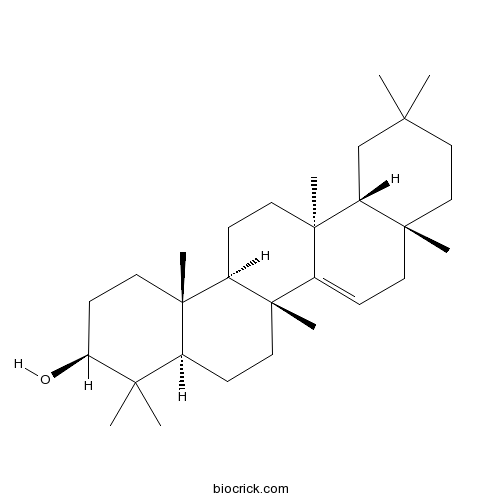A pentacyclic triterpenoid that is oleanan-3-ol lacking the methyl group at position 14, with an α-methyl substituent at position 13 and a double bond between positions 14 and 15.
InChI=1S/C30H50O/c1-25(2)17-18-27(5)13-9-21-29(7)14-10-20-26(3,4)24(31)12-16-28(20,6)22(29)11-15-30(21,8)23(27)19-25/h9,20,22-24,31H,10-19H2,1-8H3/t20-,22+,23+,24-,27-,28-,29-,30+/m0/s1
Taraxerol, a triterpenoid compound, has potent anti-inflammatory effects,it downregulates the expression of proinflammatory mediators in macrophages by interfering with the activation of TAK1 and Akt, thus preventing NF-κB activation. [1]
Taraxerol can produce triterpenoid anti-cancer compound in Agrobacterium-transformed root cultures of butterfly pea (Clitoria ternatea L.).[2]
Taraxerol can be used as a lipid biomarker for mangrove input to the SE Atlantic, the proxy-environment relations for taraxerol and Rhizophora pollen down-core show that increased taraxerol and Rhizophora pollen abundances occur during transgressions and periods with a humid climate, these environmental changes modify the coastal erosion and sedimentation patterns, enhancing the extent of the mangrove ecosystem and/or the transport of mangrove organic matter offshore.[3]
Taraxerol has inhibitory effects on AGS cell growth through inducing G2/M arrest and promotion of cell apoptosis, taraxeryl acetate has less effect on cell cycle arrest and apoptosis of AGS cells than taraxerol.[4]
[1] Yao X, Li G, Bai Q, et al. Int Immunopharmacol, 2013, 15(2):316–24.
[2] Swain S S, Rout K K, Chand P K. Appl Biochem Biotech, 2012, 168(3):487-503.
[3] Versteegh G J M, Schefuß E, Dupont L, et al. Geochim Cosmochim Ac, 2004, 68(3):411-22.
[4] Tan B, Shi H L, Ji G, et al. Journal of Chinese Integrative Medicine, 2011, 32(6):1278-84.
[5] Kumar V, Mukherjee K, Kumar S, et al. Phytochem Anal, 2008, 19(19):244-50.



